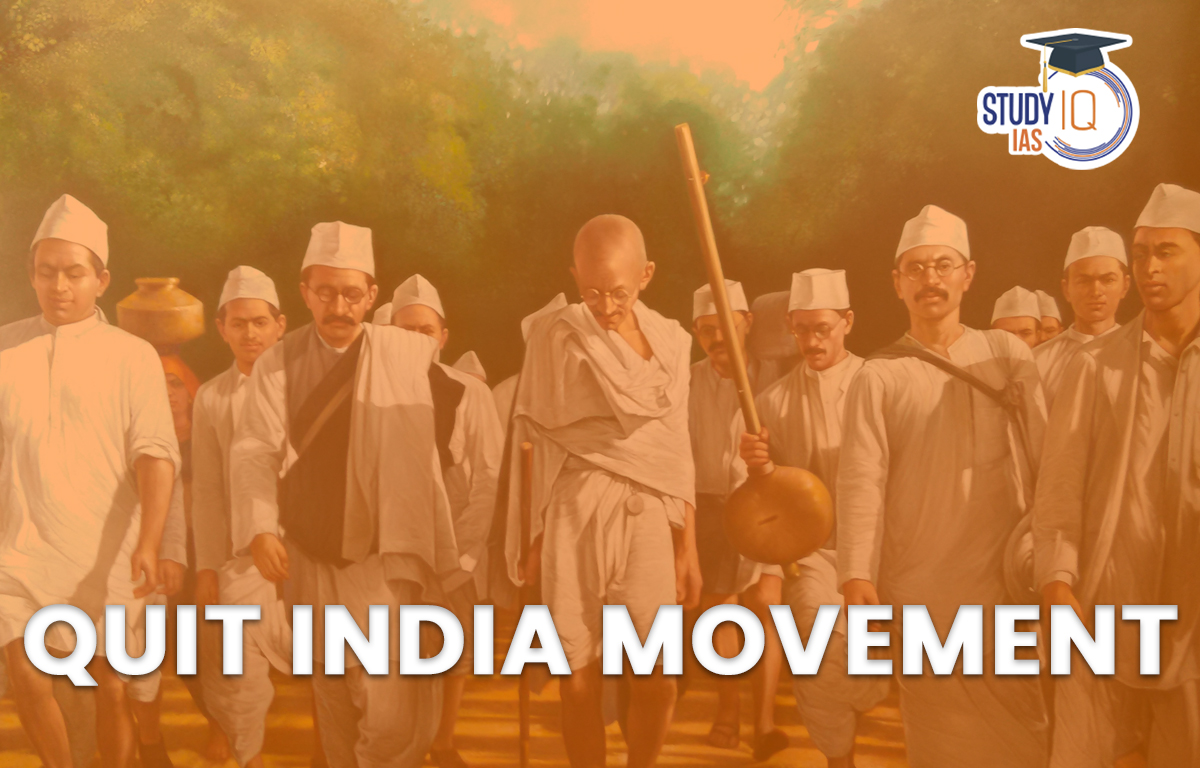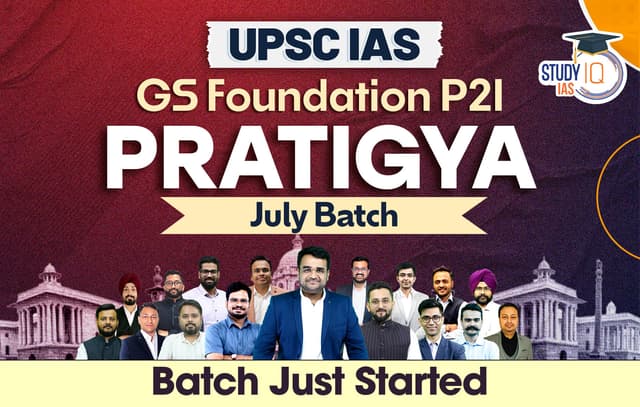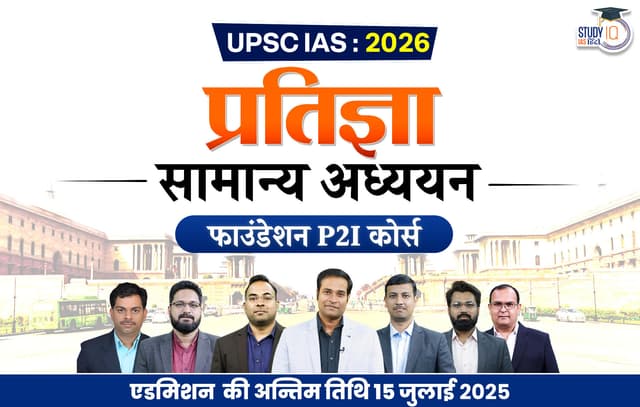Table of Contents
The Quit India Movement started on August 8, 1942, also known as the August Kranti Movement, calling for the end of British rule in India at the All India Congress Committee’s session in Bombay.
It is an important topic of the UPSC History Syllabus and an important event of the Indian Freedom Struggle for Independence. UPSC aspirants should know the complete details about Quit India Movements for Prelims and Mains.
Quit India Movement
- Quit India Movement is observed annually on August 8, 1942. Quit India Movement Day is a day to remember the sacrifices made by the Indian freedom fighters and people in their fight for independence.
- At the meeting of the All-India Congress Committee in Mumbai, Mahatma Gandhi demanded the end of British rule and launched the Quit India Movement. In his address at the Gowalia Tank Maidan, now referred to as August Kranti Maidan, Mahatma Gandhi urged listeners to “Do or Die”.
- The Indian flag was raised at the Gowalia Tank Maidan in Mumbai during the Quit India Movement by Aruna Asaf Ali, also referred to as the “Grand Old Lady” of the Independence Movement. Yusuf Meherally, a socialist and trade unionist who served as Mayor of Mumbai, is the author of the phrase “Quit India.”
Quit India Movement Causes
- Failed Cripps mission: Indian leaders reject limited British concessions.
- Dissatisfaction with British rule: Indians suffered from economic exploitation, discrimination and lack of political representation.
- Impact of World War II: Indians opposed the decision of the British to include India in the war without consultation.
- Growing nationalism: Growing nationalist sentiments inspired by leaders like Gandhi and Nehru fueled the demand for independence.
- Pressure from global movements: The success of anti-colonial movements around the world inspired Indian nationalism.
- Gandhi’s leadership: Gandhi’s call for non-violent civil disobedience united Indians against British rule.
- Suppression of civil liberties: British suppression of dissent, including the arrest of leaders, provoked anger and resentment.
Quit India Movement Phases
Quit India Movement Phases are categorised into three phases that are described below in detail. Quit India Movement Day is commemorated every year on 8 August in India.
| Phases | Description |
| First Phase | Strikes, boycotts, and picketing (protesting) were all part of the urban uprising’s first phase, which was promptly put an end to.
Workers supported the protests by staying away from the factories during the nationwide strikes and demonstrations. |
| Second Phase | The focus shifted to the countryside, where there was a significant peasant uprising that was characterized by the destruction of communication infrastructure, including railroad tracks and stations. |
| Third Phase | In the final stage, national governments or parallel governments in discrete areas came into being (Ballia, Tamluk, Satara, etc.) |
Quit India Movement of 1942 Impacts
The Quit India Movement of 1942, also known as the August Movement or Bharat Chhodo Andolan, was a civil disobedience movement that was a major turning point in India’s freedom struggle. The movement had many effects, including:
- New leaders: Aruna Asaf Ali became president of the Indian National Congress, and other new leaders emerged, including Ram Manohar Lohia, JP Narayan, and Usha Mehta.
- Political changes: Organizations like the Rashtriya Swayam Sevak Sangh, Hindu Mahasabha, and Muslim League gained popularity.
- Arrests: The government arrested nearly 100,000 people, including women and children, and kept them imprisoned until 1945. The government also declared the INC illegal and banned it.
- Complete freedom: India gained complete freedom on August 15, 1947.
Quit India Movement Importance
- The government used harsh repression tactics, but the populace was unmoved and kept up their fight.
- Even though the government claimed that independence could only be granted when the war ended, the movement emphasized that Indians must be involved in governance for it to work.
- The movement prioritized calling for total independence as the main goal of the freedom movement. Public spirit and anti-British feelings were raised.
- Underground activities were carried out by figures who eventually became well-known leaders such as Ram Manohar Lohia, J.P. Narayan, Aruna Asaf Ali, Sucheta Kriplani, and Biju Patnaik.
- Women participated actively in the movement.
- Usha Mehta, among other female activists, contributed to the establishment of an underground radio station, which sparked awareness of the movement.
- The Quit India Movement has strengthened the sense of brotherhood and unity among people.
- Many high school and college kids dropped out, while lots of adults quit their jobs and took money out of the banks.
- The costs of World War II led the British to come to the important conclusion that India was unmanageable in the long run, even though the Quit India movement collapsed in 1944 as a result of their insistence that independence could only take place when the war was over and their refusal to grant it immediately.
- The character of political negotiations with the British was altered, ultimately leading to India’s independence.
Quit India Movement UPSC
The Violence that wasn’t planned happened in certain places during the Quit India movement. The British forcefully put an end to the movement; people were shot, and lathi-charged, villages were set on fire, and huge fines were imposed. To suppress the unrest, the authorities used brutality and detained more than 100,000 individuals.
Many parties and collaborations like the Hindu Mahasabha, the Communist Party of India, and the Muslim League opposed this movement. The movement was also not supported by the Indian bureaucracy. The League opposed the British leaving India without first dividing the nation. Since the British were associated with the Soviet Union, the Communist Party supported them.
The Hindu Mahasabha publicly rejected the Quit India Movement’s appeal and boycotted it out of concern that it would lead to internal unrest and threaten internal security during the war. Subhas Chandra Bose organized the Azad Hind administration and the Indian National Army while operating from outside. Because they opposed Mahatma Gandhi’s concept, many Congress members, including C Rajagopalachari, resigned from the provincial legislature.


 Nagari Pracharini Sabha Revival: Backgro...
Nagari Pracharini Sabha Revival: Backgro...
 Ryotwari System in India, Features, Impa...
Ryotwari System in India, Features, Impa...
 Battle of Plassey, History, Causes, Impa...
Battle of Plassey, History, Causes, Impa...





















